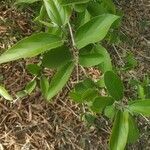| Therapeutic use
|
Colic (root), Abortifacient agents (bark), Antipyretics (bark), Asthma (bark), Cardiotonic agents (bark), Constipation (bark), Contraceptive agents (bark), Cough (bark), Epilepsy (bark), Fever (bark), Hepatitis (bark), Hypertension (bark), Hypotension (bark), Jaundice (bark), Mental disorders (bark), Muscular diseases (bark), Parasympatholytics (bark), Skin diseases (bark), Eye infections (flower), Astringents (fruit), Cathartics (fruit), Conjunctivitis (fruit), Diet, food, and nutrition (fruit), Emaciation (fruit), Endophthalmitis (fruit), Eye diseases (fruit), Eye infections (fruit), Hemorrhage (fruit), Laxatives (fruit), Pain (fruit), General tonic for rejuvenation (fruit), Respiratory tract infections (fruit), Cooling effect on body (fruit), Adrenergic antagonists (leaf), Analgesics (leaf), Antifungal agents (leaf), Anti-infective agents, local (leaf), Anti-inflammatory agents (leaf), Antiprotozoal agents (leaf), Antirheumatic agents (leaf), Arthralgia (leaf), Bites and stings (leaf), Cholinesterase inhibitors (leaf), Conjunctivitis (leaf), Diarrhea (leaf), Elephantiasis (leaf), Endophthalmitis (leaf), Eye drops (leaf), Fractures, bone (leaf), Headache (leaf), Hemorrhoids (leaf), Hypoglycemic agents (leaf), Hypotension (leaf), Malaria (leaf), Parasympatholytics (leaf), Rat-bite fever (leaf), Wounds and injuries (leaf), Abdominal pain (root), Anthelmintics (root), Anti-bacterial agents (root), Antidotes (root), Antipyretics (root), Antirheumatic agents (root), Antitubercular agents (root), Astringents (root), Bites and stings (root), Cathartics (root), Common cold (root), Constipation (root), Cough (root), Diuretics (root), Emetics (root), Emollients (root), Epilepsy (root), Fever (root), Hemorrhoids (root), Hepatitis (root), Inflammation (root), Jaundice (root), Laxatives (root), Leprosy (root), Mental disorders (root), Rabies (root), Rat-bite fever (root), General tonic for rejuvenation (root), Skin diseases (root), Vomiting (root), Diaphoretic (root), Asthma (seed), Epilepsy (seed), Fever (seed), Furunculosis (seed), Hemorrhage (seed), Hypertension (seed), Mental disorders (seed), Paralysis (seed), General tonic for rejuvenation (seed), Cooling effect on body (seed), Dropsy (unspecified), Purgative (unspecified), Vermifuge (unspecified), Emetic (unspecified), Ipecac (unspecified), Abdominal pain (unspecified), Anthelmintics (unspecified), Anti-bacterial agents (unspecified), Antidotes (unspecified), Antifungal agents (unspecified), Antipyretics (unspecified), Antirheumatic agents (unspecified), Astringents (unspecified), Bronchitis (unspecified), Cholera (unspecified), Colic (unspecified), Constipation (unspecified), Diarrhea (unspecified), Digestive system diseases (unspecified), Edema (unspecified), Emaciation (unspecified), Emetics (unspecified), Expectorants (unspecified), Eye diseases (unspecified), Fever (unspecified), Furunculosis (unspecified), Headache (unspecified), Hematologic diseases (unspecified), Hemorrhage (unspecified), Hypotension (unspecified), Inflammation (unspecified), Laxatives (unspecified), Leprosy (unspecified), Parasympatholytics (unspecified), General tonic for rejuvenation (unspecified), Skin diseases (unspecified), Snake bites (unspecified), Splenomegaly (unspecified), Syphilis (unspecified), Tuberculosis, pulmonary (unspecified), Urination disorders (unspecified), Antineoplastic agents (whole plant), Hypotension (whole plant)
|



